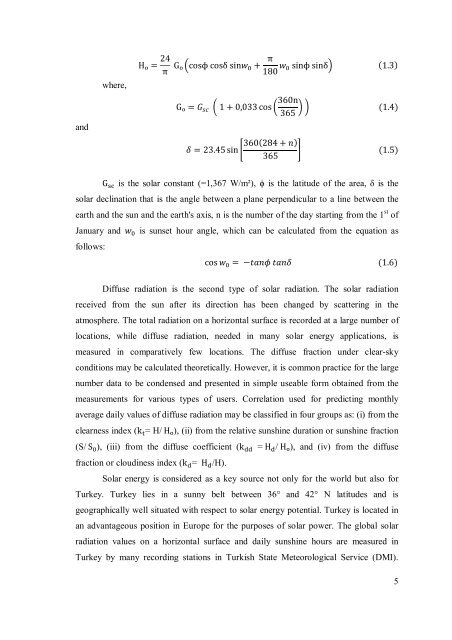measurement and comparison of solar radiation estimation models ...
measurement and comparison of solar radiation estimation models ...
measurement and comparison of solar radiation estimation models ...
Create successful ePaper yourself
Turn your PDF publications into a flip-book with our unique Google optimized e-Paper software.
<strong>and</strong><br />
where,<br />
Hₒ = 24<br />
π Gₒ cosϕ cosδ sin푤 + π<br />
180 푤 sinϕ sinδ (1.3)<br />
Gₒ = 퐺 1 + 0,033 cos 360n<br />
(1.4)<br />
365<br />
360(284 + 푛)<br />
훿 = 23.45 sin (1.5)<br />
365<br />
G is the <strong>solar</strong> constant (=1,367 W/m²), ϕ is the latitude <strong>of</strong> the area, δ is the<br />
<strong>solar</strong> declination that is the angle between a plane perpendicular to a line between the<br />
earth <strong>and</strong> the sun <strong>and</strong> the earth's axis, n is the number <strong>of</strong> the day starting from the 1 st <strong>of</strong><br />
January <strong>and</strong> 푤 is sunset hour angle, which can be calculated from the equation as<br />
follows:<br />
cos 푤 = −푡푎푛휙 푡푎푛훿 (1.6)<br />
Diffuse <strong>radiation</strong> is the second type <strong>of</strong> <strong>solar</strong> <strong>radiation</strong>. The <strong>solar</strong> <strong>radiation</strong><br />
received from the sun after its direction has been changed by scattering in the<br />
atmosphere. The total <strong>radiation</strong> on a horizontal surface is recorded at a large number <strong>of</strong><br />
locations, while diffuse <strong>radiation</strong>, needed in many <strong>solar</strong> energy applications, is<br />
measured in comparatively few locations. The diffuse fraction under clear-sky<br />
conditions may be calculated theoretically. However, it is common practice for the large<br />
number data to be condensed <strong>and</strong> presented in simple useable form obtained from the<br />
<strong>measurement</strong>s for various types <strong>of</strong> users. Correlation used for predicting monthly<br />
average daily values <strong>of</strong> diffuse <strong>radiation</strong> may be classified in four groups as: (i) from the<br />
clearness index (k = H/ Hₒ), (ii) from the relative sunshine duration or sunshine fraction<br />
(S/ S ), (iii) from the diffuse coefficient (k = H / Hₒ), <strong>and</strong> (iv) from the diffuse<br />
fraction or cloudiness index (k = H /H).<br />
Solar energy is considered as a key source not only for the world but also for<br />
Turkey. Turkey lies in a sunny belt between 36° <strong>and</strong> 42° N latitudes <strong>and</strong> is<br />
geographically well situated with respect to <strong>solar</strong> energy potential. Turkey is located in<br />
an advantageous position in Europe for the purposes <strong>of</strong> <strong>solar</strong> power. The global <strong>solar</strong><br />
<strong>radiation</strong> values on a horizontal surface <strong>and</strong> daily sunshine hours are measured in<br />
Turkey by many recording stations in Turkish State Meteorological Service (DMI).<br />
5

















